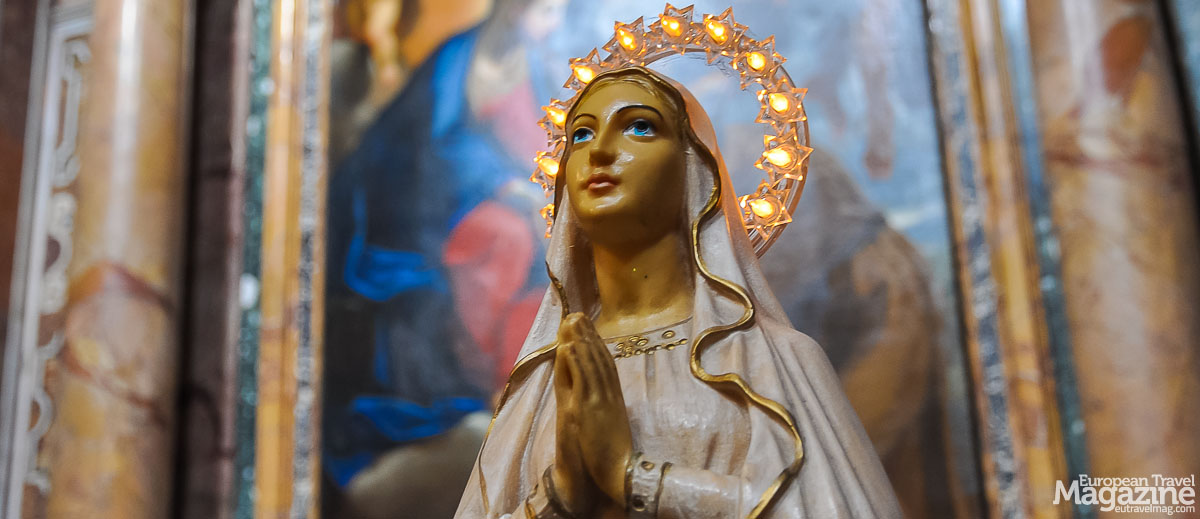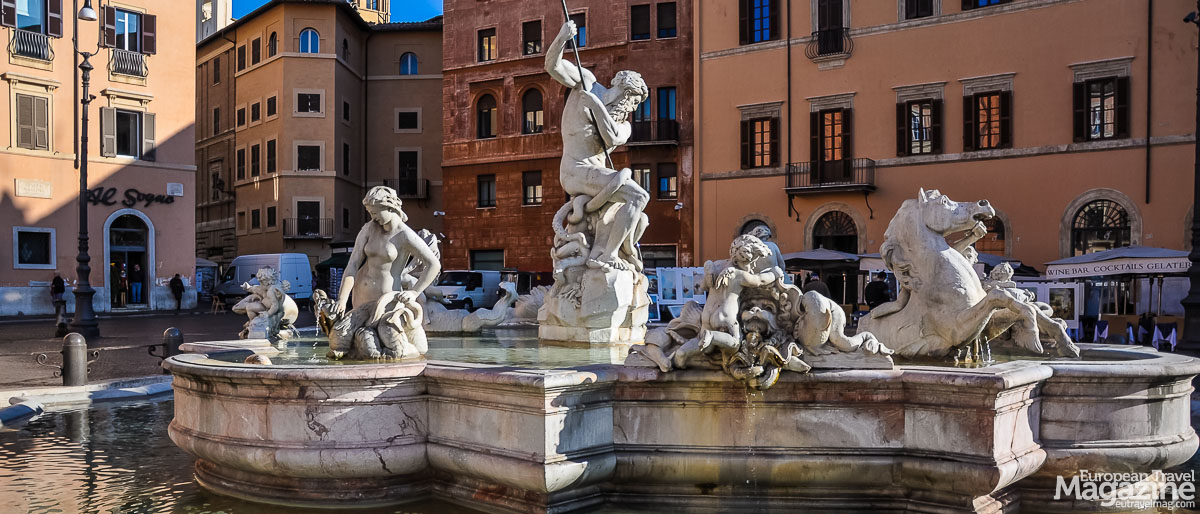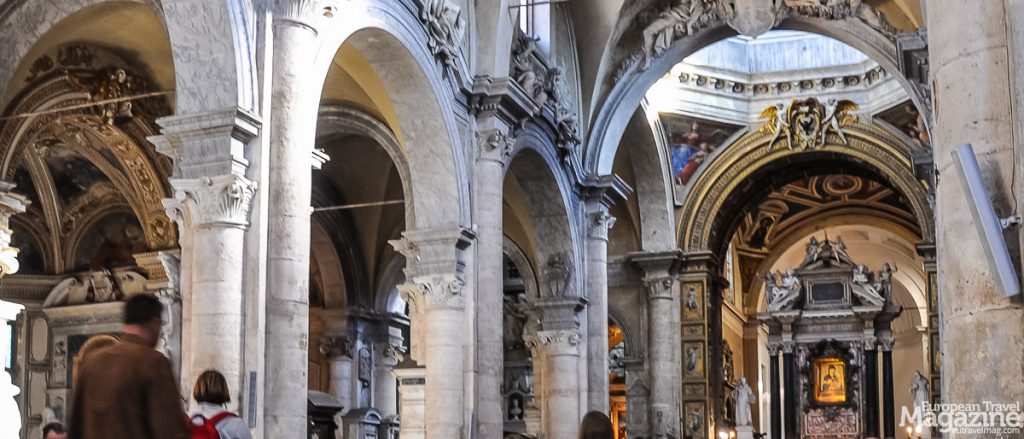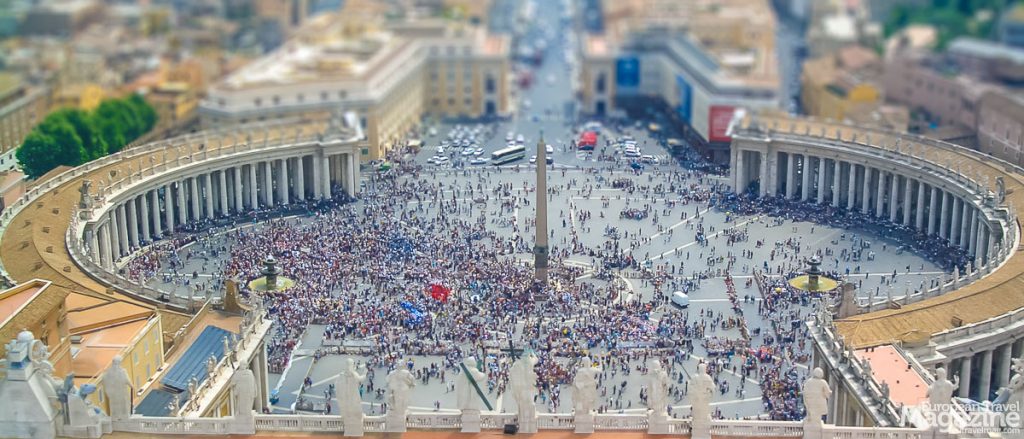Following in the footsteps of Robert Langdon in Dan Brown’s bestseller Angels & Demons takes you past some of the most beautiful sites in the Eternal City and lets you breathe the air of intrigue, mystery and revelation. While enjoying a leisurely stroll through Rome’s picturesque cobblestone alleyways, you’ll walk past some of the most beautiful and famous streets and piazzas in the world.
There are many tour-guides that offer this tour, as it is a fun way to explore Rome. If you haven’t read the book or seen the movie, your time isn’t wasted, as the guides will introduce a lot of the sites and make it enjoyable for the uninitiated.
But with a sense of adventure and a desire to spend the money on a nice lunch afterwards instead, you can do the tour yourself! The only cost is the entrance to Castel Sant’Angelo, the Sistine chapel (if you decide on the extended tour) and the Italian ice cream to keep you going!
Itinerary:
- Pantheon
- Santa Maria del Popolo church
- St. Peter’s Square
- Santa Maria della Vittoria church
- Piazza Navona
- Castel Sant’Angelo
- Passetto di Borgo (from outside)
- St. Peters Basilica
Pantheon
The main source of light in this ancient temple is the giant hole in the center of the dome. This so-called “oculus” originally served as a chimney for the smoke from the ceremonial fires which were burned on the temple’s floor. It’s this oculus, however, that throws Angels & Demons‘ main character and hero Robert Langdon into a loop in the beginning of the drama, when he mistakenly takes the oculus for “the demons hole” which they are searching for.
While the Pantheon may not look like the ruins in the Roman Forum, this spectacular building is just as old. It was built in 125 A.D. and has been in constant use ever since.
Pantheon is located in central Rome roughly between the Piazza Navona and the Trevi Fountain. It’s open every day except Christmas Day, New Year’s Day and May 1st – and it’s completely free!
Santa Maria del Popolo
Don’t be fooled by the the modest facade of the Santa Maria del Popolo church. This is one of many churches in Rome that may not be a number one attraction but still contains artworks that would be the highlight of any other city. That just proves how much magnificent artistry really is crammed into Rome. Inside the church you’ll find paintings by Caravaggio and frescoes by Pinturicchio. Even the lavish dome is adorned with mosaics by Raphael.
The church has a demon hole under ground, surrounded by earth, where the first of the kidnapped cardinals – one of the “chosen ones“ – is found with a branding mark “Earth” on the chest. Langdon and this team arrive too late to save him, but discover that the church points towards another clue.
The facade of the church was designed by Bernini. And it’s a Bernini sculpture inside that’s featured in the Angels & Demons story: the “Habakkuk and the Angel” piece. The angel points southwest, which is read as a sign that the next kidnapped cardinal is located at St. Peter’s Square.
Santa Maria del Popolo on Piazza del Popolo is open daily (although Sunday open hours are more restricted due to services) and it’s also free to visit.
St. Peter’s Square
This Angels & Demons tour is just as much a “Bernini architecture tour” as the architect supposedly created hidden Illuminati artwork in the city to guide Illuminati supporters – opposers to the vatican and supporters of science – towards a Illuminati “lair”.
St. Peter’s Square was designed by Bernini in the mid-17th century and is quite a feat, considering the many existing buildings Bernini had to work around. Locate the different wind-symbols in the center of the piazza. Here you will find an Egyptian obelisk from the 13th century B.C. At the base of the obelisk you’ll find the “West Ponente” tile, at which one of the chosen cardinals was murdered amongst the masses. With the name of another element and the second altar of science “Wind” branded on the chest. The “Western Wind” blows east and Langdon finds the next Bernini clue in line with this direction: our next destination, the Santa Maria della Vittoria church.
St. Peter’s Square is directly in front of St. Peter’s Basilica in the Vatican City inside the walls of Rome. Because it’s an outdoor space, St. Peter’s Square is always open and always free.
Santa Maria della Vittoria
Santa Maria della Vittoria is another unassuming church in Rome with a splendid interior. Built in the early 17th century, it’s a very small church by Roman standards but contains one of the more grand sculptures in Angels & Demons.
Inside the Santa Maria della Vittoria church, the left of the altar, Bernini’s statue “Ecstasy of St. Teresa” depicts the moment when, as St. Teresa writes in her biography, she “..had a vision of an angel piercing her heart”, but every following generations have speculated if this masterpiece is as much a work of erotica as religious transformation.
The Santa Maria della Vittoria church hides not far from the Termini train station. It’s open daily, although it’s closed for a few hours each afternoon – and it’s free to enter.
In this church, Roberts Langdon barely escapes the assassin, as he is right on his tail. The theme of the riddle is “Fire”, as the fire St. Teresa is feeling, and fire is the third element which burns the third cardinal and forces Langdon to hide in the bone-clad dungeon.
When analyzing the sculpture, Langdon follows the arrow of the angel, which points to one of the great landmarks of Rome: Piazza Navona
Piazza Navona
There’s a good reason why market squares in Europe aren’t called “a square”. They rarely are. This isn’t even a rectangle but rather a long oval. This is because a Roman circus used to be in this very space. And not the kind with clowns.
Instead, the Stadium of Domitian was built here back in the 1st century A.D. and ancient Romans gathered here to watch “agones” (games), and hence it was known as “Circus Agonalis” (competition arena). While the arena is long since gone, its shape remains and a reminiscence of the name (agone -> Navona) carries on.





In its center you’ll find one of the more opulent fountains of Rome. “The Fountain of the Four Rivers”, with an old Egyptian obelisk in the middle, is the work of Bernini. It’s in this fountain that the last kidnapped cardinal nearly drowns in Angels & Demons – almost sacrificed on the fourth altar of science and the final element: “Water“.
Piazza Navona is right in the heart of Rome. As it’s a public square, it’s always open and always free.
Castel Sant’Angelo
The awe-inspiring Castel Sant’Angelo was initially built as a mausoleum for the Roman Emperor Hadrian and his family in the 2nd century A.D. and has since housed a castle, a chapel, a lavish Papal residence, a prison and now a museum.
In Angels & Demons, Castel Sant’Angelo is the Illuminati lair and the secret elevated “Passetto di Borgo” actually does lead from the Castel Sant’Angelo to the Vatican City. Historically, it functioned as an escape route for Popes when the Vatican was under attack, just like Corridoio Vasariano – The secret corridor in Florence served to protect the wealthy Medici family on route from their private palace to their office.
After finally defeating the cardinal assassin, Langdon and Vittoria use the “Passetto di Borgo” to get to the Vatican to stop the anti-matter bomb from detonating.
Tours of “Passetto di Borgo” are exclusive, are only held in summer months and must be booked in advance.
St. Peter’s Basilica

While the race against time to save the kidnapped cardinals might be over, the story continues and takes us into one of the most significant places in Angels & Demons – and in Rome! This place is actually the hiding-place of an anti-matter with an immense destructive potential, which is stolen at the beginning of the novel. Here, the identity of the real brains behind the conspiracy is revealed.
While the spirit of St. Peter might guard the Gates of Heaven, his physical remains are said to rest below the main altar at St. Peter’s Basilica and many of the following Popes are also buried beneath this church. You can actually visit the tomb of St. Peter and the excavated necropolis on a so-called Scavi Tour that goes through the excavations below St. Peter’s Basilica and is one of the most exclusive tours in all of Rome. Only 250 people are allowed through each day.
Visiting St. Peter’s Basilica is easier – and cheaper! The church is not only the spiritual but also the physical centre of the Vatican City and is thus easy to locate. It’s free to enter but you’ll need patience as the security measures are thorough. And be sure your clothes are appropriate for visiting a Catholic church – it would be a shame to be turned away after a long time standing in line.
The Basilica is open daily from about 7am until 6pm and we can recommend a following visit to the Vatican Museums, St. Peter’s treasury or a climb to the dome. Even though they charge an entrance fee it’s a once-in-a-lifetime experience!
- St. Peter’s Basilica on the Vatican’s official website
- Vatican Necropolis under St. Peter’s Basilica
- Scavi tour of the Vatican Necropolis
More info:
Discover more
Get under the skin of Rome by staying here a bit longer than just one week. We can strongly recommend Crib Med for medium-term rentals in the eternal city.










































